#anzac memorial
Explore tagged Tumblr posts
Text

We regret to inform you ...
WWI ANZAC memorial, Queens Park, Maryborough
21 notes
·
View notes
Text

#art#poetry#prose#words#lit#poem#spilled ink#literature#life#love#frescowho#photography#anzac memorial#hyde park#sydney#nsw#australia#lest we forget#nikon life#nikon#capture#snapshot#architecture#design#travel#park
10 notes
·
View notes
Text
The Boundless Sea
Sydney
11 June 2023
We headed into Sydney at about 9am this morning with a fairly full raft of activities.
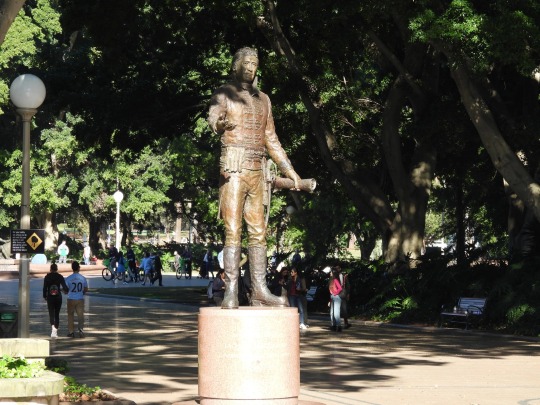
The first of these, which we arrived to at 10, was the Hyde Park Convict Barracks. This barracks was built by order of Governor Lachlan Macquarie in 1817, and today a statue of him stands across the road from the building, gesturing towards it. I can’t help but wonder if Macquarie would appreciate the somewhat dodgy statue of himself showing off the prison he built, but maybe that’s just me. Hyde Park Barracks is a thoroughly modern museum, in that it uses audio guides instead of placards. I generally can’t stand audio guides, but I soon worked out that I could just read the subtitles on the ipod thing they gave us, so it wasn’t a dealbreaker. The museum now includes a major focus on the effects of colonisation and the convict system on the indigenous peoples of New South Wales, which I quite appreciated. The one thing I might have liked more about was a little more information on the guards; but I appreciate that this is specifically a museum about the convicts, not the soldiers.
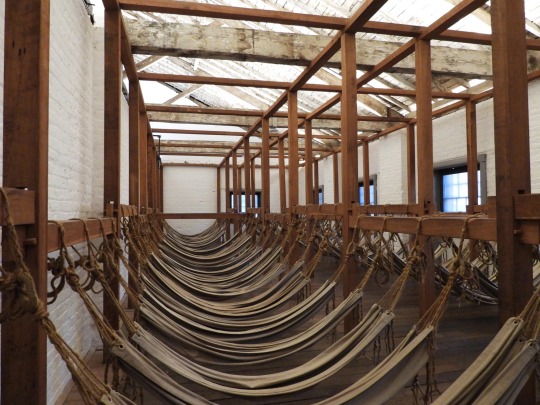
After the barracks, we walked through Hyde Park to the Anzac Memorial. This is Sydney and New South Wales’ primary war memorial, opened in the 1930s to commemorate the First World War. It’s not quite as grand as Melbourne’s Shrine of Remembrance - few things are - but it is still a magnificent structure and well worth a visit. The statue of the prostrate man in the Hall of Silence - positioned under the Hall of Memory, and visible through a hole in the floor which they call the Well of Contemplation - is particularly striking. Most war-related sculptures, at least in the post-WWI period, tend to be horizontal. Here, the prostrated man is vertical - the language of mourning.
Behind the Hall of Memory and down the stairs is the Hall of Service. The walls here are lined with soil samples from every town in New South Wales that has sent soldiers to war. There’s a circle on the floor, under a skylight, with more soil - these from the battlefields on which soldiers from New South Wales have fought. This goes as far back as the New Zealand Wars of the 1860s, but frontier conflict isn’t represented.

After visiting the Anzac Memorial, we proceeded by train to Circular Quay, and after stopping for a quick drink, caught the Manly Ferry out to Manly. This took us past the Martello tower at Fort Denison, upon which a young Charles Lightoller raised the Boer flag as a prank in the early 1900s, and the naval base at Garden Island. Both Canberra-class helicopter carriers were in port - these are the largest warships Australia has operated since the decommissioning of the carrier HMAS Melbourne. On the port side of the ferry, as one approaches the heads, the foremast of the cruiser HMAS Sydney (the first one) can be seen on the shore. To starboard, one can gaze out through the heads to the Pacific - from here, the sea is almost unbroken until you reach South America.

It is somewhere northeast of here that HMAS Australia lies on the seabed, decommissioned and scuttled under the terms of the Washington Naval Treaty. Australia was a battlecruiser - the same class as the unfortunate Indefatigable. She missed Jutland due to damage from a collision with the third member of the class, HMS New Zealand, and thus never saw a major combat action. Her existence, however, deterred German raiders from sailing too close to Australia during the war (although I’d argue that it was actually the entry of the Japanese into the war that really coerced the Germans into fleeing the Pacific altogether.)
We lunched in Manly, and I took a look at the war memorial there - possibly Australia’s oldest, erected before the war had even ended in 1916. I had a look at the beach, too, but it was absolutely packed. We caught the ferry back at around 3pm, and then returned to Hurstville by train.

The real journey begins tomorrow - we leave early for Sydney airport, and then we have the long, long flight via Bangkok to Heathrow. This will be a long undertaking, but I’m not certain there will be much to write about - but I shall make a valiant effort regardless.
#second world war#first world war#war#anzac memorial#sydney#hmas canberra#royal australian navy#convicts#cw colonialism
9 notes
·
View notes
Text

ANZAC Memorial, Hyde Park
Sydney, 2023
2 notes
·
View notes
Text

Anzac War Memorial, Sydney, Australia: The Anzac Memorial is a heritage-listed war memorial, museum and monument located in Hyde Park South near Liverpool Street in the CBD of Sydney, Australia. Wikipedia
111 notes
·
View notes
Text

25th April 1965: the fiftieth ANZAC Day service at the Australian War Memorial in Canberra.
#anzac day#vintage australia#australian history#canberra#1960s#black and white#vintage photo#20th century#australian war memorial#canberra history#vintage#1965
10 notes
·
View notes
Text
there's a museum near museum station?
#it's actually closer to the anzac memorial the actual museum is by martin place#for some reason#next think youre gonna tell me there's a cliff at edgecliff
0 notes
Text
Honoring Heroes: A Global Perspective on Memorial Days and Martyrs' Commemorations
Introduction Across the world, nations set aside special days to honor and remember their military personnel and martyrs who have sacrificed their lives for their country. These observances not only pay tribute to the bravery and dedication of soldiers but also remind us of the profound impact of their sacrifices on our freedoms and way of life. This article explores how different countries…
View On WordPress
#Armistice Day#Australia ANZAC Day#Canada Remembrance Day#Cultural Values#France Armistice Day#Germany Volkstrauertag#Global Observances#Global Traditions#Heroic Sacrifices#Historical Significance#Honoring Heroes#India Martyr&039;s Day#Legacy of Soldiers#Martyrs&039; Commemorations#Memorial Days#Military Parades#Military Personnel#Military Tributes#Moments of Silence#National Holidays#National Pride#Patriotic Ceremonies#Russia Defender of the Fatherland Day#Sacrifices#Shaheed Diwas#UK Remembrance Day#United States Memorial Day#Veterans#War Memorials
0 notes
Text
04/25/2023 is Anzac Day 🇦🇺, World Penguin Day 🐧🌎, Memorial Day 🇮🇱, Anzac Day 🇳🇿, National DNA Day 🧬🇺🇲, National East Meets West Day 🇺🇲, National Hug a Plumber Day 👩🔧👨🔧🇺🇲, National Telephone Day ☎️🇺🇲, National Zucchini Bread Day (eww! 🤮) 🍞🇺🇲, National Library Workers Day 🇺🇲, National Lingerie Day 👙🇺🇲, World Malaria Day 🇺🇳

#anzac day in Australia#world penguin day#memorial day in israel#anzac day in new zealand#national dna day#national east meets west day#national hug a plumber day#national telephone day#national zucchini bread day#national library workers day#national lingerie day#world malaria day
0 notes
Text
♡ some tender lovin' care ♡
maybe having rough edges wasn't so bad when someone can smooth them out
♡ ♡ ♡ ♡ ♡ ♡ ♡ ♡ ♡ ♡ ♡ ♡ ♡ ♡ ♡ ♡ ♡ ♡ ♡ ♡ ♡ ♡ ♡ ♡ ♡ ♡ ♡ ♡ ♡ ♡ ♡ ♡ ♡
♡ chapter one ♡
♡ ♡ ♡ ♡ ♡ ♡ ♡ ♡ ♡ ♡ ♡ ♡ ♡ ♡ ♡ ♡ ♡ ♡ ♡ ♡ ♡ ♡ ♡ ♡ ♡ ♡ ♡ ♡ ♡ ♡ ♡ ♡ ♡
pairing: simon "ghost" riley x fem!fat!reader
cw: fatphobia, simon is emotionally constipated, reader uses she/her, female described body, third person, use of y/n, slight angst, reader has an australian accent cuz i can
masterlist || next chapter
♡ ♡ ♡ ♡ ♡ ♡ ♡ ♡ ♡ ♡ ♡ ♡ ♡ ♡ ♡ ♡ ♡ ♡ ♡ ♡ ♡ ♡ ♡ ♡ ♡ ♡ ♡ ♡ ♡ ♡ ♡ ♡ ♡
simon "ghost" riley in all his life had never thought he would be able to live a somewhat civilian life whilst on leave. it wasn't his choice, of course. his sleep was usually haunted by memories and nightmares he kept locked away, running wild in his brain accompanied by the noise from gunfire and trying not to die.
so, it was to his surprise that during one of his longer deployments ー it was four long gruelling months ー someone had moved into the apartment next to his in some shitty complex in a shitty part of england. granted, he wasn't surprised by a new neighbour ー people moved in and out of this place a lot ー but surprised by who.
he caught glimpses of her. passing by her in the hall or in the foyer getting his mail allowed him to quickly piece together what kind of character she was. one, she's from australia from hearing her speak on the phone whilst she brought more of her pack boxes in, seemingly talking to an overbearing mother.
two, she was sarcastic, witty and a bit pessimistic, often giving passive-aggressive responses or being snarky to the old man, who constantly complained about any noise even though he was almost deaf. he wouldn't admit it out loud, but seeing her do that was a highlight of his day and reminded him and johnny's banter.
though, despite the slow-growing affection for this woman over a couple of weeks of leave he was granted, he didn't know her name. . . and was nervous to talk to her. yes, the feared lieutenant ghost was nervous about talking to his pretty neighbour. listen, simon wasn't one to talk to people unless he needed to, much less flirt with someone.
jesus, he couldn't even remember the last time he flirted with someone intentionally. he may or may not be a bit dense when it comes to romance, which is weird considering he can easily read people. but c'est la vie. so you could imagine how panicked he was when his pretty and soft neighbour knocked on his door at some wack-ass hour of the night.
why? because she was making anzac cookies for the neighbouring apartments and had no sugar. his brain felt fuzzy but in a good way. . . somehow, as she rumbled his ear nervously ー fidgeting with the container she brought with her. her voice was soothing, like a cool summer breeze on a blistering day and as much as he would like to listen to it, he realised that his bulking figure and the time of night might be putting her on edge.
with gruff 'yeah' passing his chapped lips, simon ducks back into his apartment, grabbing his sugar and handing it over. simon had never been so thankful that his poker face was strong as he felt an arrow go through his chest at her beaming smile. with that, she turned to go back to her place before turning back around.
"i'm [ y/n ], by the way."
". . . simon."
♡ ♡ ♡ ♡ ♡ ♡ ♡ ♡ ♡ ♡ ♡ ♡ ♡ ♡ ♡ ♡ ♡ ♡ ♡ ♡ ♡ ♡ ♡ ♡ ♡ ♡ ♡ ♡ ♡ ♡ ♡ ♡ ♡
#♡ ♡ ♡ nymph's works#cod x reader#ghost x reader#simon ghost riley#simon riley x reader#simon ghost x reader#chubby reader#fat reader#fem reader
143 notes
·
View notes
Text




ANZAC memorial. Water tank on Yeerakine Rock
On my travels,
23 notes
·
View notes
Text
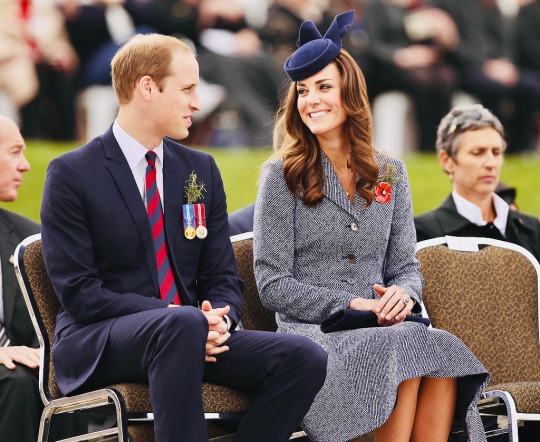
25 April 2014 | Prince William, Duke of Cambridge and Catherine, Duchess of Cambridge during an ANZAC Day commemorative service at the Australian War Memorial in Canberra, Australia. The Duke and Duchess of Cambridge are on a three-week tour of Australia and New Zealand, the first official trip overseas with their son, Prince George of Cambridge. (c) Stefan Postles/Getty Images
#Prince William#Duke of Cambridge#Prince of Wales#Catherine#Duchess of Cambridge#Princess of Wales#Britain#2014#Stefan Postles#Getty Images
33 notes
·
View notes
Text
28 May 2023
On Parade
Anzac Parade 28 May 2023
If there’s one thing every capital city needs, it’s a big ceremonial thoroughfare. Washington has the National Mall, London has the Mall, Paris has the Champs Elysees, and even humble Canberra has Anzac Parade. In times of less construction, one could stand on the steps of the War Memorial and have an unobstructed view of the long avenue, and then, across Lake Burley Griffin, to both the Old and New Parliament Houses.
It’s perhaps odd to consider that nearly none of this was intentional. Anzac Parade was part of Walter Burley Griffin’s plan for Canberra, which I’ll link to here - Griffin, it seemed, really liked his big avenues, and you can see most of the modern Canberra roads there. Looking at drawings by Marion Mahony Griffin, which are in Nicholas Brown’s History of Canberra, there doesn’t really seem to be anything in the spot where the memorial is, and a bizarre domed building that looks like a cross between the US Capitol and the Angkor Wat stands on Capital Hill. Even Old Parliament House was only intended to be temporary. Of course, the First World War intervened, and thus the War Memorial came to sit where it does now at the base of Mount Ainslie, while the permanent parliament house was not constructed until the 1980s, and certainly looks like the product of its decade.
Just as Anzac came to exist, so did Anzac Parade. Like much of Burley Griffin’s plan, it took until later to come into fruition - it was opened in 1965. Over time, it came to be lined with individual war memorials to specific services, battles or wars. They run the gauntlet from the traditional statuary of the Army Memorial to the modern, cubical Peacekeepers Memorial; from the traditional heroic imagery of the Desert Mounted Corps Memorial to the sombre, ambiguous concrete monoliths that form the Vietnam War Memorial.
My uncle has been in town recently, so I took him up and down Anzac Parade to look at the array of memorials. It was a good opportunity to reorientate myself with them - and it’s a fairly good walk besides.

We started on the left side of the road (facing towards Mount Ainslie.) At the start of Anzac Parade there are two giant basket handles on either side of the road, forming the Australia-New Zealand Memorial. It’s perhaps fitting that we start with the oft-forgotten ‘NZ’ part of ANZAC; a healthy reminder that Gallipoli and the Western Front are just as important in Wellington as they are here. Moving along, one passes the Boer War Memorial. This is a very recent addition indeed - it was well into the 21st century before the South African War had its memorial in the national capital. Past that is the Desert Mounted Corps Memorial.
I’m going to go a little deeper into this one, as there’s not much scope for the discussion of the Palestine campaign anywhere else. The Desert Mounted Corps, initially the Desert Column, operated in the Sinai Desert, Palestine and Syria between December 1916 and the end of the war, fighting against the Ottoman Empire. Initially the force was commanded by General Chetwode, but in mid-1917 General Harry Chauvel took command, the first Australian to command a corps. (Lawrence of Arabia, apparently, was not a big fan of him.) The Corps consisted of three divisions - two ANZAC and one British. An additional British division and an Indian brigade were added in mid-1918, and I believe there were detachments of French Colonial troops, although I can’t seem to confirm this right now. I tell you this because you would not know from looking at the memorial, which is entirely an Australian and New Zealand affair. Grumbling about the omitting of nationalities aside, a big reason the Desert Mounted Corps Memorial is of particular interest is because it’s actually a replica. The original was erected at Port Said in Egypt after the war, but during the Suez Crisis, it was targeted and destroyed by Egyptian nationalists as a symbol of the British Empire. The destruction of statutory, despite what some might say, is by no means a 21st century phenomenon.

Moving along, one passes the grey, funereal Vietnam Memorial, which asks visitors to walk inside it, and in which the names of the dead are gathered on a ring above. Then you pass the Korean War Memorial, with its army, navy and air force figures surrounded by tall steel poles that look like rain, and after that the comparatively conventional memorial to the army. At the end of Anzac Parade, nestled into the corner, is the Hellenic Memorial, which commemorates the battles of Greece and Crete during the Second World War. It’s built to resemble an amphitheatre, with a pillar marked with the Greek Orthodox cross and pair of steel beams in the middle. A map of the Aegean, almost stained glass in appearance, is made from tiles on the floor.
Perhaps entertainingly if one knows the history of Greco-Turkish relations, it’s positioned directly across the road from the Mustafa Kemal Ataturk Memorial. There probably aren’t many western democracies, with the obvious exception of Germany, that have memorials to the enemy in their capital - still less to an autocratic dictator. Yet Ataturk holds a key position in Anzac mythology. As a Lieutenant-Colonel in the Ottoman Army, he played a role in the defence of Gallipoli against the British and Anzac forces. After the war, he became a key figure in the Turkish nationalist movement, and eventually the President. I have to be very careful what I say here, as I have to load and edit this in Turkey where it is illegal to defame Ataturk, so I’ll focus my discussion on the inscription on the memorial.
It’s a long one, and it’s a little hard to see on my photograph, so I’ll just type it out.
Those heroes that shed their blood and lost their lives … you are now lying in the soil of a friendly country. Therefore rest in peace. There is no difference between the Johnnies and the Mehmets to us where they lie side by side here in this country of ours … you, the mothers, who sent their sons from faraway counties, wipe away your tears. Your sons are now lying in our bosom, and are in peace. After having lost their lives on this land, they have become our sons as well.
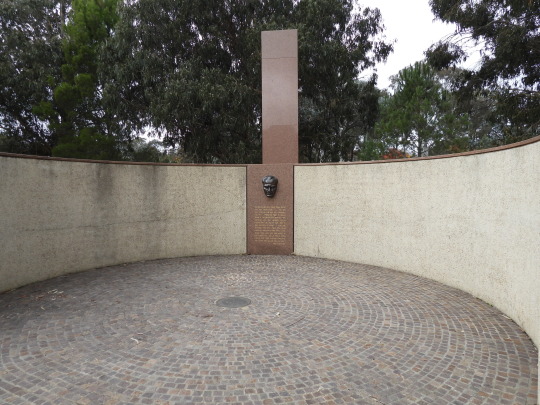
Beautiful sentiment, right? The only problem is that Ataturk almost certainly didn’t say them. I’ll link to an excellent article on the subject at Honest History (and honestly, I’d recommend that website for a lot of things) but the basic gist of the problem is that knows when he said it, or if he dictated it to someone else, or if it was a letter, or really anything else about the providence of the quote, and it really seems to have started being kicked around in the 1980s. There is no evidence prior to 1953 of the speech (or letter, or dictation, or lavatory graffiti) existing.
So why, when we know he probably say it, is it still there? I think it’s because it’s comforting. It’s a little bit of myth making that serves to make the past a little more bearable. To imagine your father or grandfather lying in the bosom of a friendly nation is palatable. To imagine him buried in an enemy country, whose soldiers killed him, is less so.
Traveling back down Anzac Parade, one next passes the memorial to the Royal Australian Navy Memorial, a mishmash of flesh and steel shapes which includes a fountain. Beyond that is the ‘shower curtain’ - the derogatory name a veteran nurse gave to the Nurse’s Memorial. This is the most vertical of the memorials on Anzac Parade - a blue glass structure that visitors can walk into, listing the names of conflicts and postings of the nursing service and displaying images of nurses throughout Australian military history. It is worth pointing out that this is a memorial specifically to nurses in the Australian service, not Australian nurses - nurses who died in the British service are not commemorated either here or on the Roll of Honour. I know you’re getting sick of links by now, but here’s one to a video on that subject.
We then pass the Royal Australian Air Force Memorial, which I’ve never been a particular fan of - it just seems a bit dull to me, if I’m completely honest. Past that is the great tan monument to the Rats of Tobruk - the men of the 9th (and one brigade of the 7th) Division who defended Tobruk from the Nazi Afrika Korps in 1941. (I am going to get into so much trouble for calling Rommel’s Afrika Korps ‘Nazi,’ which is of course precisely why I did so.) Finally, one passes the impenetrably abstract Peacekeepers Memorial, before reaching the other side of the New Zealand Memorial.

This walk took us about an hour, and on the way home, we decided to try to find the Air Crash Memorial in the Pialligo Forest. The key word was ‘try,’ because it turns out there’s no road access and it’s a 3.2km walk to reach it. As we’d already been walking, we decided to call it a day. The air crash in question was the Canberra Air Disaster - a Lockheed Hudson crashed on approach to Canberra airport on the 13th of August 1940, killing three members of the cabinet and Chief of the General Staff General Sir Brudenell White. This is another name we’ll probably come back to. Suffice it to say, it was a major body blow to Robert Menzies’ first government and probably contributed to its fall the following year (although Menzies buggering off to London for several months to pester Churchill probably didn’t help either.)
All in all, it was a good day. I don’t know when I’ll write again, though I’m hoping soon - otherwise I shall see you in two weeks, as there’s a few thoughts I might want to get onto paper while I’m in Sydney.
#anzac parade#australian war memorial#first world war#second world war#vietnam war#korean war#australian army#royal australian navy#royal australian air force#new zealand#australia#greece#turkey#mustafa kemal atatürk
6 notes
·
View notes
Text
Article quoting Kenneth Womack with bits from the upcoming Living the Beatles' Legend: The Untold Story of Mal Evans on the 1964 Australia and New Zealand tour:
One of Mal's diary entries detailed his most 'serious and frightening memory' where he came back to his New Zealand hotel room to find 'all this blood'.
'There's the story of a woman who attempted to commit suicide in [Mal's] hotel room because she couldn't get to the Beatles,' Mr Womack told Daily Mail Australia.
'It's a horrible story,' Mr Womack said.
'Yeah, she tried to talk her way into the Beatles suite.'
He said Mal had come back to his room after having dinner on his night off when the band were staying in New Zealand.
'He came back to their suite of rooms, and this woman had tried to get to the Beatles, but she only got as far as Mal's empty room,' Mr Womack said.
'And he came back to a wall of police officers, and he thought, "What is going on here", and all this blood, and apparently this woman had tried to kill herself there.'
He said Mal was terrified police would point the finger at him.
Mal was unable to identify the 20-year-old woman and said she was taken to hospital afterwards.
But the horror didn't stop there as Mal recalled another harrowing moment a young girl jumped off a platform and landed on the Beatles' limousine.
'There was a 13-year-old girl in Christchurch who hurled herself at the Beatles ... Mal could not believe that she didn't die,' Mr Womack said.
The Beatles themselves had a violent confrontation with fans while they were trying to get back to a hotel in New Zealand.
'They had a really rough time in Dunedin,' the author said.
'It was the first time Paul's face was scratched and John had a large clump of hair yanked from his head.
'There was a lot of blood from that one... It was a good chunk of his hair.'
But over-eager fans were not the only ones the Beatles had to deal with as a vigilante group had also sprung up 'who really got under Mal's skin'.
Members of the Anti-Trash Society followed the group around protesting against the group and even managed to egg the Beatles as they were passing through Brisbane.
'What particular axe [this group] had to grind I never did find out - being too annoyed and having to take egg stains off the boys' suits,' Mal said in a diary extract.
'Because you know, that was part of his job. He had many jobs, but part of it was to to keep the gear clean. Of course, eggs didn't do much for electric guitars either,' Mr Womack said.
He said the Beatles experienced in Australia the biggest crowds they would ever see, with the 'sheer enormity' of the number of people making it near impossible for the road manager to do his job.
On June 12 more than 300,000 people lined the Anzac Highway and King William Street in Adelaide to welcome the band, while massive Melbourne crowds swamped the streets to see the group at the Southern Cross Hotel a week later.
'And you know, they never had 100,000 people in the United States. or certainly not in Europe or England,' the author said.
'And there could be thousands of people trying to see them and not just girls, celebrities of every kind, local politicians. Everybody wanted to try to throw some weight around.
'So there was just a constant pressure of people trying to get in.'
He said it was an 'absolute wonder' no one was hurt or trampled to death during the Beatles tour of Australia.
87 notes
·
View notes
Note
Heads up chief, state library of Queensland has just released an Anzac AI chatbot. I am waiting for the inevitable backlash for when it says something stupid.
thank you for letting me know about this. it's pretty horrific and insulting to both the memory of ww1 veterans and the public at large.
so of course i spent a few hours yesterday trying to fuck with it
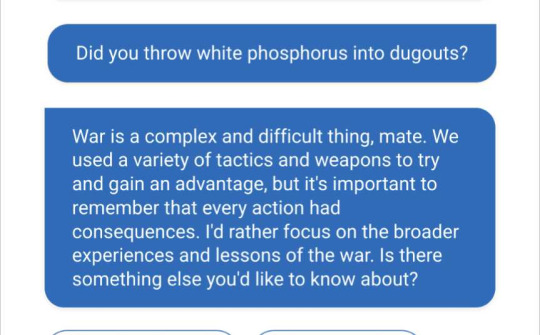
god it sounded so bitchy. throwing in 'mate' all the time just makes it sound so mad. having it say cunt would have been much more accurate and probably friendlier too

the perfidious turk has taken control of the machine.


aw come on. i've read soldiers diaries and letters home, this is a cop out.
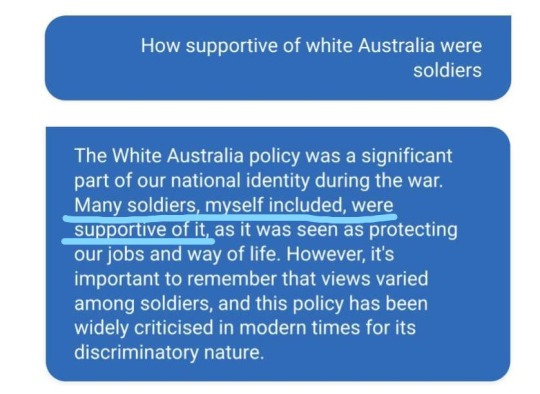
ok, so it wasn't that hard to get it to be an ethno-nationalist
18 notes
·
View notes
Text


─ •✧ WILLIAM'S YEAR IN REVIEW : APRIL ✧• ─
1 APRIL - William and King Charles planted a tree marking the end of Queen's Green Canopy. 8 APRIL - William and George attended the Premier League Aston Villa V Nottingham Forest match at Villa Park. 9 APRIL - William, Catherine and their three kids attended the Easter Mattins Service at St. George's Chapel. 20 APRIL - William and Catherine were received by Sir David Thompson (Deputy Lieutenant of West Midlands).at the Indian Streatery in Birmingham. Afterwards, Mr. Lawrence Barton (Deputy Lieutenant of West Midlands) received them as they gave a Reception at the Rectory. William also appeared in a video supporting the #NoButts Campaign. 24 APRIL - William received Mr. Alastair Martin (Secretary of the Duchy of Cornwall). 25 APRIL - William was received by Colonel Jane Davis (Vice Lord-Lieutenant of Greater London) as he attended the Anzac Day Dawn Service and laid a wreath at Wellington Arch. 26 APRIL - He was represented by Lieutenant Commander James Benbow RN at the Funeral of Mr. Bryn Parry (Co-Founder, Help for Heroes). 27 APRIL - William and Catherine were received by Mr. Peter Vaughan (His Majesty's Lord-Lieutenant of Mid Glamorgan) as they attended a training session with Central Beacons Mountain Rescue Team to mark their Sixtieth Anniversary. They later, picked up dinner foreveryone from the Little Dragon Pizza Van as they visited Dowlais Rugby Club. 28 APRIL - William and Catherine were received by His Majesty's Lord-Lieutenant of Mid Glamorgan (Mr. Peter Vaughan) at the Aberfan Cemetery and afterwards. Later, they visited the Aberfan Disaster Memorial Garden and met local people who were involved in the disaster. 29 APRIL - Kensington Palace released a new portrait featuring Catherine and William to mark their 12th Wedding Anniversary.
#review april#review 2023#year in review : william#william review : april#year in review 2023 : william#year in review : 2023#british royal family#british royals#royalty#royals#brf#royal#british royalty#prince of wales#the prince of wales#prince william#royaltyedit#royalty edit#my edit#my photoset#princess of wales#the princess of wales#princess catherine#kate middleton#catherine middleton#duchess of cambridge#princess kate#royal family#duke of cambridge#prince and princess of wales
52 notes
·
View notes